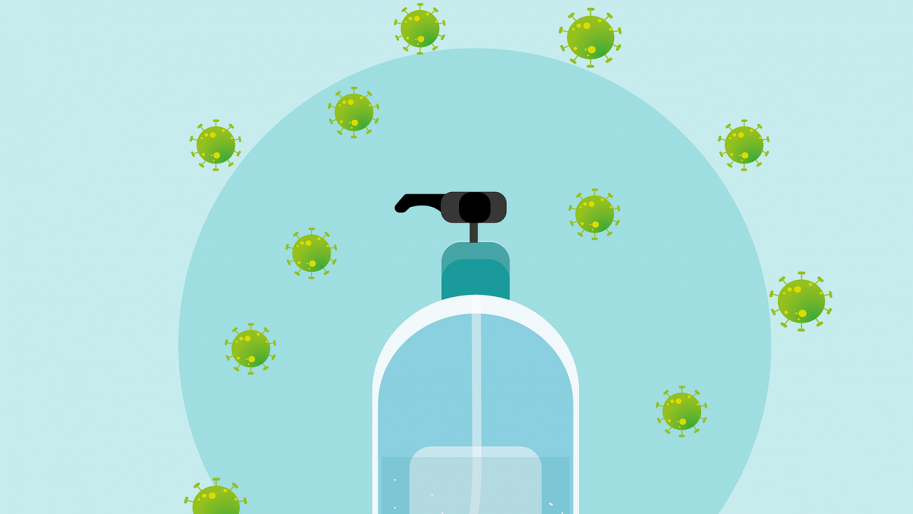Entering the third year of the pandemic, everyone – from cleaning and janitorial service providers to the general public – could be forgiven for showing signs of mental exhaustion. We’ve had two full years of research, messaging, iteration of protocols and practices, conclusions, lessons learned.
In such a climate, effectively a war of mental attrition, how does the cleaning industry ensure it remains fresh, focused, effective, and exemplary, particularly as we move into spring and a full-capacity reopening for many retail and hospitality facilities?

Brian Sansoni
Though diligence and communication are paramount, it’s largely as simple as practising the basics of hygiene of infection control, says Brian Sansoni of the American Cleaning Institute (ACI), which plays a leading role in helping to advise, define, and shape the cleaning industry in the U.S. and Canada, and whose members include the manufacturers, formulators, suppliers, and distributors of cleaning products used in household, commercial, industrial, and institutional settings.
FC&M spoke to Sansoni about the challenges retail and hospitality facilities face amid higher foot traffic and loosened restrictions, and what service providers, staff, and facility owners and operators must keep in sharp focus to ensure the high standards of the pandemic are retained.
Some responses have been edited for length and clarity.
What does cleaning for health mean now, in the third pandemic year?
“For some time now, we’ve been far beyond cleaning for appearance – it has been, and still is, all about cleaning for the health and safety of your employees, the folks on the front line, and for your customers. For those shops, hotels, restaurants etc. that are now open at full capacity, it’s crucial to re-evaluate their place of business.
“The basics are that you should be disinfecting high-touch surfaces and objects and high-traffic areas on at least a daily basis, whether that’s elevator buttons, escalators, basket and trolley handles, seats, checkout and payment areas. Continue to promote hygiene and disinfection with your staff – everything from washing hands to handling deliveries with care and hygiene. Keep safety top of mind.”
How does the lifting of restrictions in many jurisdictions change the nature of the game?
“There will be a lot of folks who haven’t been comfortable venturing out much, and there will be a pent-up demand for wanting to get out and about, whether that is shopping, eating out, travel. From a facility operators’ point of view, if a customer hasn’t been in your store or your facility for a long time, you need to make sure they see that you care. Make sure cleaning processes are visible, sanitizer stations are refilled, your washrooms are clean, you have wipes on offer – instill that confidence in them.
“The due diligence never stops – this all needs to be happening when the customers aren’t there, too. It’s your next chance to make a great impression. Cleaning and hygiene are still front and centre for millions of consumers and customers and diners and visitors. With restrictions being lifted in a lot of jurisdictions, it’s important that the cleanliness of your store is apparent and that customers can recognize that.”
What are the particular challenges of managing the cleanliness of retail and hospitality facilities?
“Sanitation and hygiene are heightened concerns in retail and hospitality because there is so often food involved. There are all kinds of food safety concerns just as a recourse of doing business; in an ongoing pandemic, those are multiplied. So, I think there should and will be heightened precautions taken in those businesses.
“Also, a lot of the problems the industry sees around cleaning products and chemicals stem from improper storage in commercial settings. Again, that concern is magnified where there’s food involved, like hospitality and retail. Standards have always had to be so, so high, but that need has become more acute.”
Many industries have struggled with labour challenges in recent months. What can be done to mitigate that as foot traffic increases?
“Make sure your cleaners – whether they are your in-house staff or a hired third-party cleaning service – are properly and adequately trained in how to handle cleaning products, chemicals, and so forth. You cannot cut corners. We have seen a lot of people in the hospitality and retail sectors realize the staff constraints, and they have primarily adjusted their hours accordingly.
“Sometimes, you have to make tough decisions because you can’t compromise health and safety and hygiene. You just can’t. Restaurant owners, grocers, etc. will continue to make decisions based on those standards. How many staff are needed to fulfill the health and safety and hygiene brief? How must your processes change to meet the demands of the latest situation? I think it’s inevitable that staffing levels will dictate how you go about these things. Primarily, though, and especially in this labour market, you want to show that you care about your employees and your customers.”
What needs to be the focus now, in the third pandemic year?
“Our surveys have shown that the attention consumers are paying to how commercial facilities are showcasing cleaning and hygiene practices has remained perfectly high. Hygiene and safety remain key concerns for consumers. Just as the public’s own personal practices and standards have remained high on the agenda, so have their expectations from businesses and facilities. The trauma of the last two years is sticking with people, and it’s sticking with businesses and facilities too. We’d be very unwise to see cleaning and hygiene become a lower priority. These things were taken for granted a lot before the pandemic but now we’ve raised standards and raised awareness, that can’t be allowed to drop.
“It’s not about being obsessive, it’s just about being smart: reminders of common-sense situations. It’s those smart, targeted practices that are really important in retail settings, hospitality settings, restaurant settings. That’s how to keep customers, visitors, and employees in your workplace safe and how to keep your business and your facility successful. There should be a high level of permanence there.”
Finally, are there any myths that still need dispelling around cleaning?
“The too-clean myth still persists in some cases. Even setting aside the pandemic, you still see a not insignificant number of people affected by foodborne illness or by hospitality-acquired infections, caused in no small part by insufficient cleaning and disinfection practices. I don’t want to hear that you can clean too much. I think what got lost in some of this ‘too-clean’ stuff is common sense. Of course, you don’t need to clean every five minutes, but you do need to wash your hands numerous times a day, particularly where food is involved. You do need to disinfect high-touch and high-traffic areas numerous times a day.
“I think the ‘too-clean’ myth is detrimental to the idea of smart cleaning, which is integral to public health. This is not rocket science. A lot of the basics remain the same; have those materials and procedures, and if your employees recognize and partake in those, that’s half the battle. It’s all well and good having the chemicals and the products, but you must use them the right way and store them correctly. This all comes back to that ‘cleaning is caring’ mantra, and that will continue to be a very important platform. Show that in your business. Use the right products in the right way at the right times.”
This interview was also published in the Spring 2022 issue of FC&M magazine.








